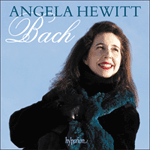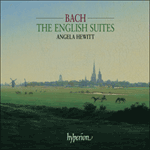
Welcome to Hyperion Records, a British classical label devoted to presenting high-quality recordings of music of all styles and from all periods from the twelfth century to the twenty-first.
Hyperion offers both CDs, and downloads in a number of formats. The site is also available in several languages.
Please use the dropdown buttons to set your preferred options, or use the checkbox to accept the defaults.

Then comes a rather big dose of Courantes—two, in fact, and the second with two variations or doubles. Couperin often wrote series of Courantes in the same key, but it is unusual in Bach. It is not an easy dance to get a hold of, either as a player or as a listener—nor for a dancer, I imagine, as its rhythmic subtleties can be quite complicated. All of the courantes in Bach’s English Suites are of the French variety (the Italian corrente being another kettle of fish, and a much livelier dance), and this is often ignored by pianists who seem to find in them a bit of a romp. Nothing could be further from the true character of the dance. The four we have here are a lesson in ornamentation, especially the second Courante with its Italian-style flourishes in the first double, and the walking bass in the second.
The Sarabande of the A major suite provides the great moment of the entire work. Seventeen of the thirty-two bars contain the swirling motive of the first bar which then soars upwards, resting on the second beat (a rhythmic characteristic of the dance). The melody is more Italian than French with its long phrases and curves. Unlike the other sarabandes of the English Suites, this one is already highly embellished to start with, leaving little room for ‘improvement’ on the repeats.
To conclude we have two high-spirited Bourrées (the first in the major key making a feature of two-note slurs; the second in the minor which stays in the lower half of the keyboard—another thing which Couperin often did), and a Gigue which will be remembered by all those who have played it for the annoying trills in both hands. The piano marking at the end of each section is Bach’s own, showing that he preferred to end this piece with charm rather than bravura.
from notes by Angela Hewitt © 2003
Apparaît ensuite une dose assez élevée de Courantes—deux, en fait, et la seconde venant avec deux variations ou «doubles». Si Couperin a souvent écrit des séries de Courantes dans la même tonalité, le phénomène est plutôt rare chez Bach. Il ne s’agit pas d’une danse aisée à maîtriser, que ce soit pour le musicien qui joue, ou l’auditeur qui écoute—et encore moins pour le danseur—du moins c’est ce que j’imagine puisque les subtilités rythmiques sont vraiment compliquées. Toutes les courantes des Suites anglaises de Bach relèvent de l’esthétique française (l’italien corrente est une autre paire de manches et une danse bien plus animée). Il s’agit d’un trait souvent ignoré des pianistes qui semblent trouver en elles bien plus d’animation qu’elles n’en contiennent. Rien ne pourrait être plus éloigné du véritable tempérament de cette danse. Les quatre que nous avons ici sont une leçon d’ornementation, en particulier la seconde Courante avec ses ornements de style italien dans le premier double et la basse allante dans le second.
La Sarabande de la Suite en la majeur se trouve être le grand moment de toute l’œuvre. Dix-sept des trente-deux mesures contiennent le motif convoluté de la première mesure qui s’élève ensuite comme une flèche pour se reposer au second temps (une caractéristique rythmique de cette danse). La mélodie est plus italienne que française, avec ses longues phrases et ses courbes. Contrairement aux autres sarabandes des Suites anglaises, celle-ci est hautement embellie dès le début, ne laissant que peu de place aux «améliorations» portées dans les reprises.
Pour conclure, nous avons deux Bourrées animées (la première en majeur lie les notes deux à deux, une de ses caractéristiques; la seconde en mineur reste dans la partie grave du clavier—autre aspect fréquent chez Couperin) et la Gigue que tous ceux qui l’ont jouée se rappeleront pour ses trilles aux deux mains énervants à réaliser. La notation piano à la fin de chaque section est bien de Bach, montrant qu’il préférait conclure cette pièce avec charme plutôt que bravoure.
extrait des notes rédigées par Angela Hewitt © 2003
Français: Isabelle Battioni
Danach kommt eine recht hohe Dosis an Couranten—zwei, um genau zu sein, wobei die zweite noch zwei Variationen oder „Doubles“ hat. Couperin schrieb oft ganze Serien von Couranten in derselben Tonart, bei Bach ist dies jedoch ungewöhnlich. Weder für den Ausführenden noch für den Hörer ist die Courante ein einfacher Tanz—und wahrscheinlich ebensowenig für einen Tänzer, da die rhythmischen Feinheiten recht kompliziert sein können. Alle Couranten in Bachs Englischen Suiten richten sich nach dem französischen Vorbild (die italienische corrente ist eine ganz andersartiger Tanz und sehr viel lebhafter) und dies wird von vielen Pianisten ignoriert, wenn sie sie als Tollereien auffassen. Nichts könnte dem tatsächlichen Charakter des Tanzes weniger entsprechen. Die vier in dieser Suite sind eine Lektion in Ornamentierung, insbesondere die zweite, die italienische Gesten im ersten „Double“ hat und einen schreitenden Bass im zweiten.
Der Höhepunkt des gesamten Werks ist die Sarabande der A-Dur Suite. In 17 der 32 Takte wird das wirbelnde Motiv des ersten Taktes verarbeitet, was dann in die Höhe schnellt und auf dem zweiten Schlag innehält (ein rhythmisches Charakteristikum des Tanzes). Die Melodie ist wegen ihrer langen Phrasen und Bögen eher als italienisch denn französisch zu bezeichnen. Anders als die übrigen Sarabanden der Englischen Suiten ist diese bereits zu Anfang reichlich verziert und kann in den Wiederholungen kaum noch „verbessert“ werden.
Zum Abschluss erklingen zwei sehr temperamentvolle Bourréen (die erste steht in Dur und ein wichtiges Merkmal sind die gebundenen Zweitongruppen; die zweite steht in Moll und spielt sich in der unteren Hälfte der Tastatur ab—eine weitere Couperinsche Eigenart) sowie eine Gigue, die allen denjenigen bekannt sein dürfte, die sie wegen ihrer lästigen Triller gespielt haben. Die Markierung piano am Ende eines jeden Teils stammt von Bach selbst und zeigt, dass er dieses Stück nicht mit Bravour sondern Charme enden lassen wollte.
aus dem Begleittext von Angela Hewitt © 2003
Deutsch: Viola Scheffel
 Bach: Angela Hewitt – The Bach Recordings Bach: Angela Hewitt – The Bach Recordings‘One of the record glories of our age’ THE SUNDAY TIMES. For the first time ever, Angela Hewitt’s complete recordings of the Bach keyboard works on Hyperion are presented in one collection of 27 CDs. This covers nearly 25 years of Angela’s Bach re ...» More |
 Bach: Angela Hewitt plays Bach Bach: Angela Hewitt plays BachAngela Hewitt’s acclaimed recordings of Bach on the piano have received the highest critical acclaim and found their way into thousands of homes, selling nearly 400,000 copies since her recording of the Inventions burst onto the scene in 1994. Now ...» More |
 Bach: The English Suites Bach: The English Suites |

